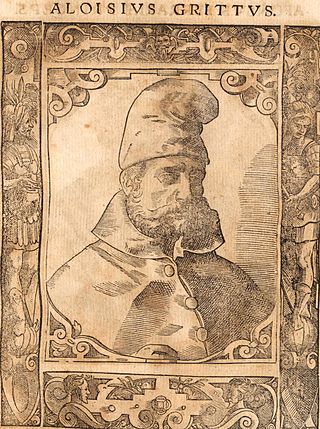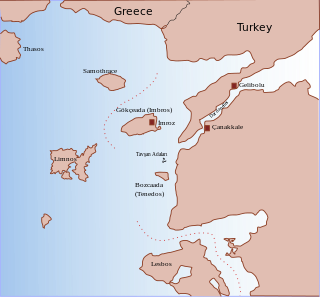Claude Alexandre, Count of Bonneval, was a French army officer who later went into the service of the Ottoman Empire, eventually converting to Islam and becoming known as Humbaracı Ahmet Paşa.

Beyoğlu is a municipality and district of Istanbul Province, Turkey. Its area is 9 km2, and its population is 225,920 (2022). It is on the European side of Istanbul, Turkey, separated from the old city by the Golden Horn. It was known as the region of Pera surrounding the ancient coastal town Galata which faced Constantinople across the Horn. Beyoğlu continued to be named Pera during the Middle Ages and, in western languages, into the early 20th century.

Andrea Gritti was the Doge of the Venetian Republic from 1523 to 1538, following a distinguished diplomatic and military career. He started out as a successful merchant in Constantinople and transitioned into the position of Bailo, a diplomatic role. He was arrested for espionage but was spared execution thanks to his good relationship with the Ottoman vizier. After being freed from imprisonment, he returned to Venice and began his political career. When the War of the League of Cambrai broke out, despite his lack of experience, he was given a leadership role in the Venetian military, where he excelled. After the war, he was elected doge, and he held that post until his death.
The Treaty of Constantinople was signed on 25 January 1479, which officially ended the sixteen-year-long war between the Republic of Venice and the Ottoman Empire. The Venetians were forced to hand over Scutari in Albania and the island of Lemnos and the Mani Peninsula in Greece; and acknowledge the loss of Negroponte (Euboea) and Croia. The treaty allowed a full restoration of Venetian trading privileges in the Ottoman Empire against an annual flat tax of 10,000 ducats, as well as a 100,000 ducats in arrears owed by Venetian citizens to the Porte.

Relazioni were the final reports presented by Venetian ambassadors of their service in foreign states. Relazioni contained descriptions of the current political, military, economic, and social conditions of the country visited. Relazioni are important to historians for recording the development of diplomacy in early modern Europe.

An Ahdname, achtiname, ahidnâme or athname is a type of Ottoman charter commonly referred to as a capitulation. During the early modern period, the Ottoman Empire called it an Ahidname-i-Humayun or an imperial pledge and the Ahdname functioned as an official agreement between the Empire and various European states.

Francesco Contarini was the 95th Doge of Venice, reigning from 8 September 1623 until his death fourteen months later. He was a member of the House of Contarini, one of the founding families of Venice.

The Ottoman–Venetian peace treaty of 1419 was signed between the Ottoman Empire and Republic of Venice, ending a short conflict between the two powers, confirming Venetian possessions in the Aegean Sea and the Balkans, and stipulating the rules of maritime trade between them.

Alvise Gritti was a Venetian politician. He was influential in the Hungarian Kingdom under the reign of King John I of Hungary. He was also a minister of the Ottoman sultan, and regent of Hungary from 1530 to 1534. He was the natural son of Andrea Gritti, the Venetian Bailo of Constantinople during the reign of Sultan Bayezid II, who later became the Doge of Venice in 1523.
Matteo Zane was the Patriarch of Venice from 1600 to 1605.
Girolamo Cappello was a Venetian ambassador.
The European consuls in the Ottoman Empire began as informal relationships between merchants residing in the Empire and the Sultan. The relationships were defined by the ahdname granted by the Sultan which would stipulate the religious freedom and exemption from the taxes that non-Muslim subjects had to pay. The religious implications of these relationships diminished over time as the commercial aspects took over.
In countries outside of its borders, a foreign power often has extraterritorial rights over its official representation. If such concessions are obtained, they are often justified as protection of the foreign religion such as the ahdname or capitulations granted by the Ottoman Sultan to commercial Diasporas residing in the Ottoman Empire. The Sultan did not see this agreement as a bilateral agreement between equals, but merely as acknowledging the nation of foreigners living within his territory and offering them privileges similar to those given to non-Ottoman subjects. However, the European states viewed the ahdname as formal and official and therefore had difficulty enforcing the privileges to their satisfaction on many occasions.
Bailo or baylo is a Venetian title that derives from the Latin term baiulus, meaning "porter, bearer". In English, it may be translated bailiff, or otherwise rendered as bailey, baili, bailie, bailli or baillie. The office of a bailo is a bailaggio. The term was transliterated into Greek as μπαΐουλος (baioulos), but Nicephorus Gregoras translated it ἐπίτροπος or ἔφορος.
Pantaleone Barbo was a distinguished diplomat of the Venetian Republic. He was the Venetian ambassador to Constantinople, and became the first bailo of Corfu in 1389. Amongst his other diplomatic appointments, he served as Provveditore of Crete in 1363, captain of Crete in 1389, and duke of Crete in 1395. He also served as bailo and captain of Negroponte.
Andrea Biagio Badoer was a Venetian administrator and diplomat.

The Venetian navy was the navy of the Venetian Republic which played an important role in the history of the republic and the Mediterranean world. It was the premier navy in the Mediterranean Sea for many centuries between the medieval and early modern periods, providing Venice with control and influence over trade and politics far in excess of the republic's size and population. It was one of the first navies to mount gunpowder weapons aboard ships, and through an organised system of naval dockyards, armouries and chandlers was able to continually keep ships at sea and rapidly replace losses. The Venetian Arsenal was one of the greatest concentrations of industrial capacity prior to the Industrial Revolution and responsible for the bulk of the republic's naval power.

The Battle of Gallipoli occurred on 29 May 1416 between the fleets of the Republic of Venice and the Ottoman Empire off the port city of Gallipoli, the main Ottoman naval base. The battle was the main episode of a brief conflict between the two powers, resulting from Ottoman attacks against possessions and shipping of the Venetians and their allies in the Aegean Sea in 1414–1415. The Venetian fleet, under Pietro Loredan, was charged with transporting a Venetian embassy to the Ottoman sultan, but was authorized to attack if the Ottomans refused to negotiate. The subsequent events are known chiefly from a detailed letter written by Loredan after the battle.
Beatrice Michiel, also known as Fatma Hatun, was a Venetian spy in service in the Ottoman court, under the sultans Murad III and Mehmed III.
Giovanni Dario was a Venetian official who served multiple times as ambassador of the Republic of Venice. His family hailed from Crete, a Venetian colony at the time; his knowledge of Greek allowed him to serve as interpreter and envoy to Constantinople during the last years of the Byzantine Empire. After the Fall of Constantinople he rose to the position of secretary of the Duke of Crete, and from 1464 entered service with the Signoria of Venice. He was repeatedly sent as ambassador to the court of the Ottoman Empire and the Mamluk Sultanate, most notably helping conclude the First Ottoman–Venetian War in 1479.











